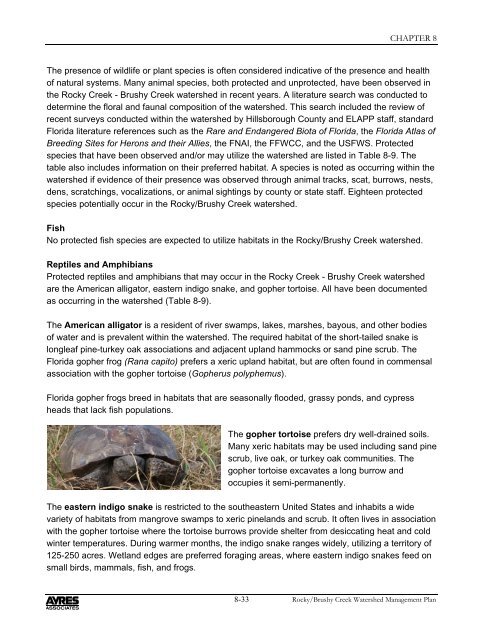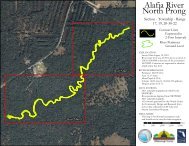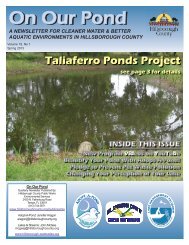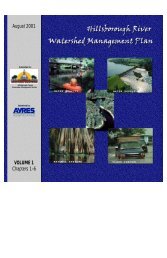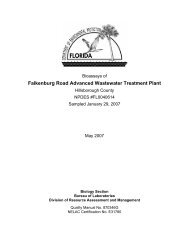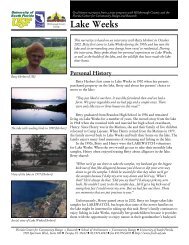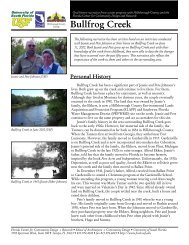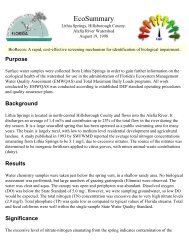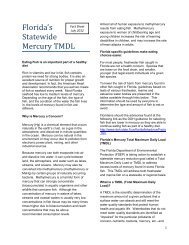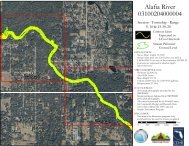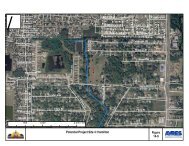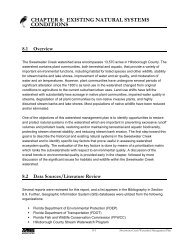Rocky Brushy Creek Watershed Mgmt. Plan (2007) -- Part 2
Rocky Brushy Creek Watershed Mgmt. Plan (2007) -- Part 2
Rocky Brushy Creek Watershed Mgmt. Plan (2007) -- Part 2
Create successful ePaper yourself
Turn your PDF publications into a flip-book with our unique Google optimized e-Paper software.
CHAPTER 8The presence of wildlife or plant species is often considered indicative of the presence and healthof natural systems. Many animal species, both protected and unprotected, have been observed inthe <strong>Rocky</strong> <strong>Creek</strong> - <strong>Brushy</strong> <strong>Creek</strong> watershed in recent years. A literature search was conducted todetermine the floral and faunal composition of the watershed. This search included the review ofrecent surveys conducted within the watershed by Hillsborough County and ELAPP staff, standardFlorida literature references such as the Rare and Endangered Biota of Florida, the Florida Atlas ofBreeding Sites for Herons and their Allies, the FNAI, the FFWCC, and the USFWS. Protectedspecies that have been observed and/or may utilize the watershed are listed in Table 8-9. Thetable also includes information on their preferred habitat. A species is noted as occurring within thewatershed if evidence of their presence was observed through animal tracks, scat, burrows, nests,dens, scratchings, vocalizations, or animal sightings by county or state staff. Eighteen protectedspecies potentially occur in the <strong>Rocky</strong>/<strong>Brushy</strong> <strong>Creek</strong> watershed.FishNo protected fish species are expected to utilize habitats in the <strong>Rocky</strong>/<strong>Brushy</strong> <strong>Creek</strong> watershed.Reptiles and AmphibiansProtected reptiles and amphibians that may occur in the <strong>Rocky</strong> <strong>Creek</strong> - <strong>Brushy</strong> <strong>Creek</strong> watershedare the American alligator, eastern indigo snake, and gopher tortoise. All have been documentedas occurring in the watershed (Table 8-9).The American alligator is a resident of river swamps, lakes, marshes, bayous, and other bodiesof water and is prevalent within the watershed. The required habitat of the short-tailed snake islongleaf pine-turkey oak associations and adjacent upland hammocks or sand pine scrub. TheFlorida gopher frog (Rana capito) prefers a xeric upland habitat, but are often found in commensalassociation with the gopher tortoise (Gopherus polyphemus).Florida gopher frogs breed in habitats that are seasonally flooded, grassy ponds, and cypressheads that lack fish populations.The gopher tortoise prefers dry well-drained soils.Many xeric habitats may be used including sand pinescrub, live oak, or turkey oak communities. Thegopher tortoise excavates a long burrow andoccupies it semi-permanently.The eastern indigo snake is restricted to the southeastern United States and inhabits a widevariety of habitats from mangrove swamps to xeric pinelands and scrub. It often lives in associationwith the gopher tortoise where the tortoise burrows provide shelter from desiccating heat and coldwinter temperatures. During warmer months, the indigo snake ranges widely, utilizing a territory of125-250 acres. Wetland edges are preferred foraging areas, where eastern indigo snakes feed onsmall birds, mammals, fish, and frogs.8-33<strong>Rocky</strong>/<strong>Brushy</strong> <strong>Creek</strong> <strong>Watershed</strong> Management <strong>Plan</strong>


